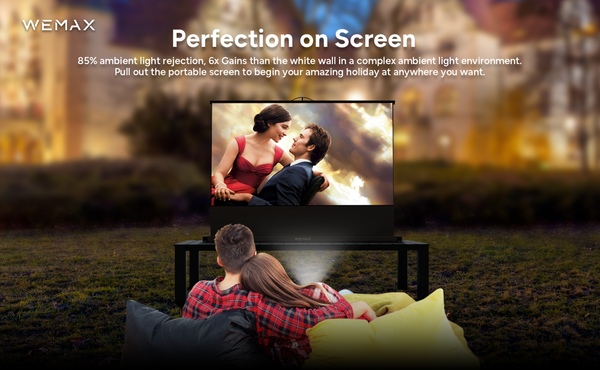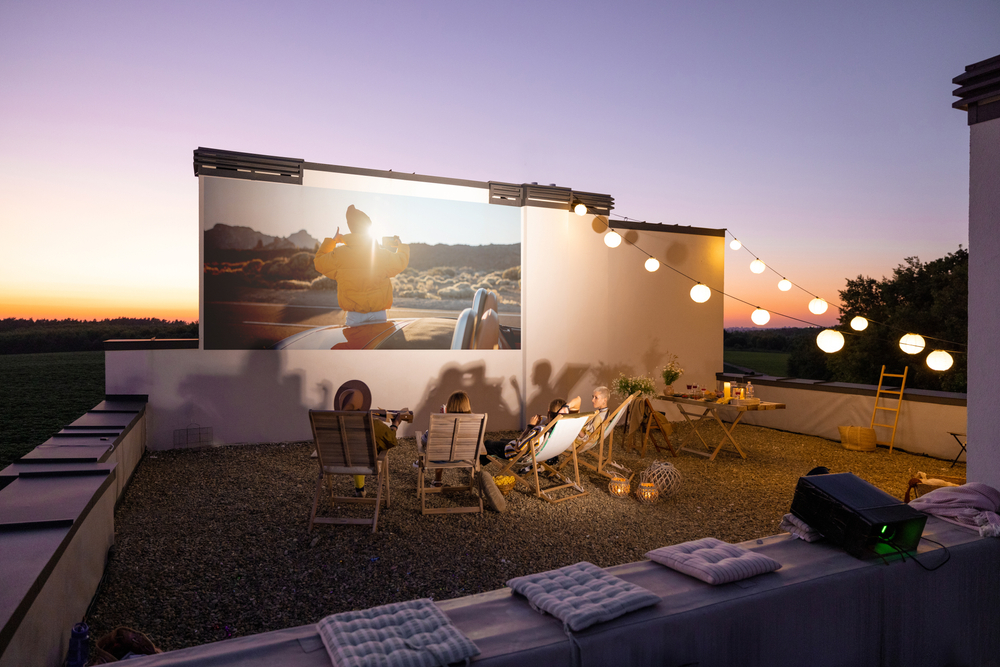When it comes to projectors, lighting has always been an important consideration regarding the quality and accuracy of their projection. Their brightness of course affects the output image, but the ambient lighting also plays a role and even the way your screen rejects light. After all, ideally, you'd want your screen to only truly react to the light of your projector.
So today we are taking a closer look at screens, lighting, and how these factors play into the quality of your projections, so you can make the most out of your setup at home.
Table of Contents:
- What Is Light Rejection and Why Is It Important?
- What is an ALR Projector Screen?
- What is a CLR Projector Screen?
- ALR vs. CLR Screen: What’s The Difference?
- Do You Need an ALR/CLR Screen?
- WEMAX Projectors: The Best Projectors for Home Theater, Business, Gaming, and Camping
- Wrapping It Up
What Is Light Rejection and Why Is It Important?
When we bring up light rejection this is a concept directly related to projector screens and their manufacturing. In short, a light-rejecting screen can absorb ambient light to avoid redirecting it towards the user, and instead only reflects the projected image at the viewer; ensuring that a projector can work even in a bright environment.
But why is this technology so important?
First and foremost it provides additional versatility to your setup, after all with a regular screen some projectors won't be able to properly display an image if the ambient light is too high. However, their design also means that they have anti-glare technology making your movie sessions safer and less straining on your eyes.
READ MORE: Why Brightness or Lumens Matters to Projectors
While all screens might appear similar at first glance the fact is that their composition varies a lot. Flat screens reflect light at a very sharp angle making so much of the projection get reflected into the ceiling.
Screens with repeating optical structures try to solve this issue by making sure that the central area of the screen is reflected your way, but the borders nonetheless lose a lot of brightness. Last but not least, gradient optical structures manage to properly reflect the entire projection towards the viewer due to their adaptive design reacting to the projection.
What is an ALR Projector Screen?

ALR stands for Ambient Light Rejection, and it refers to projector screens designed to only reflect light that is right directly in front of it. These screens reflect all light sources from other angles away from the viewer, resulting in an improved viewing experience as long as the projector is directly in front of it and no other source of light is in that range.
ALR screens ensure a bolder and brighter image as they bounce more lighting back to the viewer while making sure ambient light does not get in the way. This means that they provide much better projections on bright areas and even during the day, dramatically increasing the versatility of your setup. The contrast and black ratio also see an improvement even in bright areas. However positioning is key with an ALR projector screen, so you must make sure your projector has a horizontal beam and you must also be located in front of the screen to get the best visual experience.
What is a CLR Projector Screen?

CLR stands for Ceiling Light Reflection and while they also employ light rejection technology to make sure your projection looks as bright as possible even in bright areas the mechanics behind a CLR projection screen are considerably different.
CLR screens are designed to reject the light that comes from above, hence the ceiling in their name. This means that houses with bright overhead lights or skylight windows during the day will be able to make the most out of these screens by comparison.
One of the most important aspects of CLR screens is that they focus their light rejection capabilities on light absorption instead of reflection. This means that ambient light is truly removed from the picture, making sure that your display is as sharp and accurate as possible. While CLR screens can reduce ambient light from all directions they excel at ceiling light as mentioned above and a good screen can reduce ambient light from above by 95%.
Prospective owners must keep in mind that CLR projector screens are designed for one specific style of projectors, and those are ultra-short throw units or UST projectors for short. Due to their design, a CLR screen will reject any overhead or ceiling-mounted projector. And they are designed to properly reflect light to the viewer from the sharp and close angle UST projectors employ in their beam. Other models and uses will not result in ideal conditions.
ALR vs. CLR Screen: What’s The Difference?
While CLR and ALR projection screens are both light-rejecting screens meant for home and business projecting it is undeniable that they have key differences. Each style of the screen uses different technologies and is designed for different models of projectors altogether.
READ MORE: How to Choose the Right Screen Size for Your Home Projector
As such it isn't a matter of discussing ALR vs CLR screens. They both have their strengths and their intended uses, and which one is better simply comes down to your specific circumstances.
However, to clear that up we'll be taking a closer look at the differences between these two styles of screens in three specific categories. That way it'll be easier to know which one will benefit you the most and help you enjoy better projections.
Direction of Light
ALR screens are designed to reject light from all sources except directly in front of them. This means that if your current location has multiple sources of light like lamps, windows, or other displays, an ALR projector screen will help you considerably.
While CLR screens do offer some level of light rejection from all directions they are first and foremost designed to combat light from above. If the main sources of ambient lighting in your projection area come from the ceiling you'll get more mileage out of a CLR projector screen.
The projector type is of course another major consideration, and one of the most important things to keep in mind when buying a new screen. ALR screens generally will work with any model as they simply care about the light source being in front of them. This means that an ALR screen will work with any projector, both at home and in the office and if the projector gets replaced your old screen will still work as intended.
CLR screens are completely optimized for ultra-short throw projectors and just won't look as well with any other models. So if you have an existing UST projector there's no reason not to pick a CLR screen, but for general uses, they are far more limited.
Ambient Lighting Control
Another major difference with these screens is the way they control the ambient lighting. ALR screens will bounce ambient lighting away from the viewer to ensure they don't affect the projection quality, and they will reflect any light provided it doesn't come from the front.
CLR screens on the other hand absorb light, up to 95% of it even. This can result in even better contrast and color accuracy for your projection, but it does require that the projector and screen are carefully aligned with each other.
Do You Need an ALR/CLR Screen?
In broad terms yes. The fact is that a simple fabric screen or your wall won't allow your projector to show the image quality it was designed for. Ambient light will always be present to some degree, and these screens help you overcome this problem and make sure you see the image as it was intended to appear.
Of course, you'll see the biggest difference if you regularly project in bright areas, so your setup will play a large role in your choice. Nonetheless, it's undeniable that ALR and CLR models offer many advantages compared to traditional models, and that you'll eventually want to upgrade if ensuring the highest quality is your priority.
WEMAX Projectors: The Best Projectors for Home Theater, Business, Gaming, and Camping

We've discussed all the essentials when it comes to CLR and ALR screens, and now it's time to look at some specific models. At WEMAX rich visual experiences are our priority, so you can rest assured that all of these screens have been designed and manufactured with the utmost care to ensure they provide the highest possible quality.
WEMAX 120-inch Electric Tension Floor ALR UST Raising Screen
If you want a large size-screen with zero hassle this is the model for you. This screen raises on your own ensuring that it takes no space and no effort. And its multi-layered build that includes light-reflecting filters and an optical sawtooth structure means that ambient light won't be an issue with this screen.
WEMAX 100-inch UST CLR/ALR Fixed Frame Screen
If you want a large and high-quality screen for your UST projector this is the way to go. Its sleek design makes it easy to set it up anywhere, and its layered build provides you with certified quality color reproduction. Your projections will never look crisper than with this screen.
WEMAX 50-inch ALR Portable Projector Screen
If you are looking for a smaller screen that is easier to carry on the go then take a look at our 50-inch portable screen. You can simply set up this screen on any floor or table and pull it up to have a hassle-free screen anywhere. And since it's an ALR screen it will work with any projector in the market, adding up to its versatility.
Wrapping It Up
Light will always play a role in the way projections are displayed. Projectors rely on the light after all, and this means that other sources of light can considerably affect how a projection looks. Thankfully ALR and CLR screens provide a solution thanks to their light rejection technology and can help you enjoy movies even in bright rooms. So consider one for your next purchase, and keep in mind their differences so you can make the most out of your projector.
At WEMAX we take light seriously and are always at the forefront when it comes to new light and laser applications for projection. We are the leading brand for projector solutions, and this means our screens are carefully designed to make sure they complement projectors and truly provide you with the rich visual experiences you deserve.
Related blogs from WEMAX
How to Choose the Right Screen Size for Your Home Projector
15 Creative Outdoor Projector Screen Ideas for Your Backyard
How to Choose Your Ideal Outdoor Projector Screen?
Be the first to know the latest updates, tips, how-tos, exclusive deals, and discounts from WEMAX. Sign up for our newsletter today!



Share:
Is A 100-inch Projector Screen Right for Your Home?
How to Choose the Screen for your Ultra Short Throw Projector